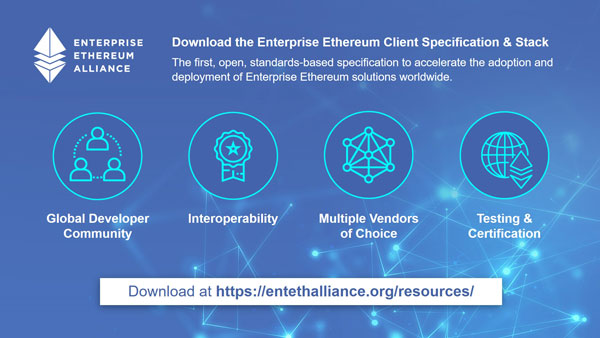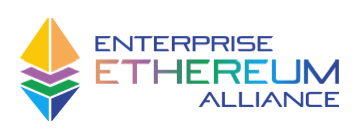Enterprise Ethereum Alliance Specification Clears the Path to a Global Blockchain Ecosystem
May 16, 2018
EEA Specification-based Enterprise Ethereum Smart Contracts and Transactions are “What’s Next” in the Web 3.0 Blockchain Revolution
NEW YORK, N.Y. – May 16, 2018 –Until today, organizations were required to build proprietary variations of a private-permissioned Enterprise Ethereum implementation. With today’s Enterprise Ethereum Alliance (EEA)release of the Enterprise Ethereum Client Specification 1.0, organizations and the global development community now have a single, open-source, cross-platform standards-based framework to speed up business transactions, build a greater trust in contracts, and create more efficient business models. The EEA Specification incorporates components developed by the Ethereum Foundation and is available as a free public document to download.
- Learn more about the EEA and download the Enterprise Ethereum Client Specification
- Sign-up to receive the latest EEA information
- Join the 500+ member companies of the EEA

By replacing costly and ineffective multi-protocol propriety approaches, enterprises everywhere can begin developing new ways to create customer value across entire markets – from banking, law, and healthcare to advertising, communications and more. Based on the Enterprise Ethereum Architecture Stack, this open, cross-platform distributed ledger framework will give rise to the next decentralized internet era, Web 3.0. Blockchain is so important that it is expected to exceed $3.1 trillion in business value-add by 2030, according to Gartner. Ethereum is already one of the broadest developer user bases worldwide, and the EEA Specification will make Ethereum applicable as a standards-based, enterprise-ready approach.
“The EEA’s Enterprise Ethereum Specification is the result of 18 months of intense collaboration between leading enterprise, technology and platform members within our technical committee,” said EEA Executive Director Ron Resnick. “This EEA open-source, cross-platform framework will enable the mass adoption at a depth and breadth otherwise unachievable in individual corporate silos. With over 500 organizations as members, we anticipate great things in 2018 as EEA members work with the global development community to build, test and certify solutions to grow the ecosystem.”
By using the EEA Specification, Ethereum developers can write code that enables interoperability, motivating enterprise customers to select EEA specification-based solutions over proprietary offerings. By taking advantage of hybrid architectures, the EEA Specification provides insight into the future of scalability, privacy, and security – a single, interoperable, development framework for spanning both permissioned and public Ethereum networks. Additionally, the framework includes industry-specific application layers defined by the EEA Special Interest Groups to reduce contract and transaction costs and increase the number of new novel applications.
The EEA has plans to introduce a TestNet to further assure interoperability across member solutions. In addition, the EEA will oversee a members-only Certification Program that ensures solutions conform and interoperate with the standard, building confidence in an offering’s performance.
About the EEA
The EEA is a member-led industry organization based on the goal of empowering the use of Ethereum blockchain technology as an open standard for the betterment of all industries, focused on the needs of enterprises. For additional information about joining the EEA, please reach out to [email protected].
Supporting Member Quotes
“The public release of the EEA Specification is a significant milestone in enabling an open ecosystem of innovation across enterprise blockchain use cases, from global enterprises to startups. Accenture is proud to be a founding EEA member, and we’re ready to leverage the EEA Specification and coming TestNet and Certification Programs to drive an entirely new way of delivering value to enterprise customers,” David Treat, vice chairman of the EEA, and managing director and global blockchain lead at Accenture.
“The EEA’s Specification and growing membership will accelerate the acceptance and deployment of Ethereum blockchain solutions in the global marketplace. The technological breadth, depth, and variety of organizations that can take advantage of the EEA’s standards-based specification will accelerate the growth of the Enterprise Ethereum ecosystem,” said Julio Faura, chairman of the EEA, a founding EEA member from Banco Santander, and head of R&D for Blockchain at Banco Santander.
“The EEA specification represents a new and seamless way for enterprises to leverage Ethereum to develop innovative, blockchain based solutions,” said Lior Glass, an EEA member from BNY Mellon, and Global Blockchain Lead, at BNY Mellon’s Emerging Business & Architecture, Investment Services Technology Group. “As a Founding EEA Member, we are excited to help create a new industry standard that supports the continued adoption of blockchain in the financial services industry.”
“The EEA Enterprise Ethereum Client Specification 1.0 release is the first step in creating a thriving ecosystem for Enterprise Ethereum-centric architectures. These solutions will deliver improved privacy and performance for a wide variety of applications including digital identities, supply chains, financial industry platforms, consumer financial services and any industry that values some collaboration among competing entities. The broad coalition of EEA members signals the strong commitment of the global enterprise community to utilize this open standard,” said Joseph Lubin, a founding EEA member from ConsenSys, co-founder of Ethereum, and founder of ConsenSys.
“Microsoft joins the other members of the EEA in celebrating the release of the Enterprise Ethereum Client Specification 1.0 open standard for high-performance, cross-platform enterprise blockchain. With this significant step, the EEA has defined a modern layered architecture designed to deliver a high-performance, cross-platform solution and ecosystem for the global enterprise community comprised of the world’s largest companies and the most innovative startups,” said Marley Gray, a founding EEA member from Microsoft, and principal architect, Azure Blockchain Engineering at Microsoft.
“Intel is committed to enabling blockchain adoption and, as a founding member, is pleased to see the Enterprise Ethereum Alliance release this specification, addressing privacy and security among other requirements,” said Rick Echevarria, a founding EEA member from Intel. and vice president, Software and Services Group, General Manager, Platforms Security Division at Intel Corporation. “We look forward to seeing developers and organizations derive tangible benefit from the framework.”
“We’re very pleased to see the EEA reach and release its 1.0 specification. Great open standards depend upon great open source software, so we’re very happy that the Hyperledger Sawtooth developer community has the goal of EEA 1.0 compatibility. This is yet one more way in which the Hyperledger and Ethereum communities are not competitors but allies,” said Brian Behlendorf, executive director, Hyperledger
